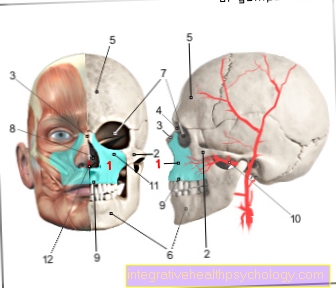Liver Hemangioma - Is It Dangerous?
definition
Liver hemangioma is the most common benign liver tumor and is 3: 1 more common in women. It consists of fine blood vessels, which is why it is commonly referred to as blood sponges. The reasons for its formation are unknown. Often there are no fulminant symptoms, so that a hemangioma of the liver is more of an incidental finding in imaging examinations. If necessary, symptoms in the upper abdomen or a feeling of fullness with nausea can occur in the case of larger findings.
The cavernous hemangioma is also an important special form of hemangioma. To learn more about it, read: Cavernous Hemangioma - How Dangerous Is It?

Is Liver Hemangioma Dangerous?
Whether a hemangioma can be dangerous depends on the one hand on its severity or growth in size, and on the other hand on its location in the liver. A degeneration in the sense of a cancer disease has never been observed.
The hemangioma of the liver is in most cases an incidental finding. Any symptoms can therefore be relatively unspecific and initially not steer in the right direction. In addition to upper abdominal discomfort such as pain, nausea can also occur.
If rare complications such as bleeding from the hemangioma occur, general weakness and paleness, as well as pain, can occur. Bleeding can occur if the hemangioma is very close to the surface of the liver and is very large (over 5 cm in diameter).
The hemangioma can also grow within the liver in the vicinity of important vessels, such as the biliary ducts. If these are narrowed, it is possible that the bile drainage is obstructed and jaundice (yellowing of the skin) occurs. This is best recognized by the conjunctiva of the eyes.
Read more on the topic: Jaundice
Does Liver Hemangioma Pain?
In most cases, a hemangioma of the liver does not cause any symptoms, including pain. Occasionally it can lead to unspecific upper abdominal complaints. These mainly occur when the liver hemangioma is getting larger or is already particularly large. In addition, there are complaints such as a feeling of fullness and nausea. Pain usually only occurs with very large liver hemangiomas. Since the liver itself is not well supplied with pain-conducting nerve fibers, pain only occurs when the capsule of the liver is stretched so much that the pain fibers it contains are irritated.
You might also be interested in this topic: Liver pain
Can a hemangioma go away on its own?
The hemangioma of the liver is one of the benign tumors. Two factors play an essential role here: On the one hand, the hemangioma rarely spreads, it does not react with the surrounding tissue and thereby does not impair liver function. On the other hand, most liver hemangiomas resolve on their own over time. Therapy of the hemangioma is therefore only necessary in the rarest of cases. Often times, a liver hemangioma is discovered by accident. Follow-up checks are then carried out until the hemangioma disappears by itself.
What do you do when the hemangioma gets bigger?
A hemangioma usually does not need treatment because it is only one benign (= benign) mass. In most cases, the hemangioma does not pose a risk as it does not impair the functioning of the liver. However, if the hemangioma becomes larger, there is a risk of rupture, i.e. the blood sponge tearing and bleeding into the liver. This can damage the liver cells or, in the case of particularly large hemangiomas of the liver, lead to severe blood loss. In this case, therapy for the hemangioma can be considered. There are various methods of doing this: You can sclerot the hemangioma with chemical substances so that it is no longer supplied with blood. Alternatively, surgical removal of the hemangioma can be performed, but this is not standard therapy for a hemangioma of the liver.
What is a cavernous hemangioma?
A cavernous hemangioma of the liver is the term used for blood sponges, which consist of very large spaces filled with blood. The term cavernous (Cavern = created cavity) describes a hemangioma which does not consist of many small accumulated vessels, but in which one vessel expands to a particularly large extent. Since the cavernous hemangioma of the liver also arises from a vessel, the lining of the hemangioma “cavity” consists of Endothelium, the innermost cell layer that is also found in normal blood vessels. With cavernous hemangiomas of the liver, there is a somewhat greater risk of rupture (risk of the blood sponge tearing) compared to other hemangiomas, which means that the risk of bleeding is slightly higher than with other hemangiomas.
Read more on the topic: Cavernous hemangioma
Removal of a hemangioma using surgery
The distance a hemangioma will usually rarely necessary. Surgery should be considered if the patient is over 5 cm tall and in an unfavorable position. In the event of diagnostic uncertainty, a Sampling make sense which minimally invasive is carried out. If the hemangioma constricts important structures in the liver, it may also be necessary to remove it, for example to restore the flow of bile. Basically, a minimally invasive approach of a so-called "open" operation is always preferred, in which a larger incision is made on the upper abdomen. The surgeon makes the decision after carefully examining the constitution, the previous operations and the general health of the patient. If bleeding occurs due to a tear in the liver hemangioma, an operation must be performed immediately.
causes
The causes of liver hemangioma are largely unknown. They can be innate and not cause any discomfort for a lifetime. In women under the strong influence of female hormones, as happens during pregnancy or when taking the “pill”, these benign tumors can be observed more frequently. Pre-existing liver hemangiomas can also grow during pregnancy, so the hormonal factor plays a decisive role.
Hemangioma of the liver in pregnancy
The hormonal changes in the female body have been shown to affect the growth of hemangiomas in the liver. Here progesterone and estrogen play an important role. Since these hormones are also found in oral contraceptives (“pill”), increased growth can also occur when they are used. If hemangiomas are known in a pregnant woman, they do not necessarily have to cause symptoms, but their size and position should be checked regularly to avoid possible complications such as bleeding. This can be done in the standard ultrasound examinations, but can also be monitored in additional appointments as required. MRI can be used as an alternative cross-sectional imaging method; computed tomography would be too much radiation exposure for mother and child. A hemangioma of the liver usually has no effect on the unborn child
Hemangioma of the liver and the "pill"
Depending on the preparation, the pill contains a hormone composition that is produced by a pregnant woman's body. Taking the pill simulates pregnancy for the female body, so to speak. The hormones contained are mostly estrogen and progesterone. These have been shown to influence the growth of hemangiomas in the liver. If a woman is known to have a hemangioma, regular checks for changes such as growth in size should be carried out by means of ultrasound examinations as part of contraception with the pill.
Read more on the topic: The pill
diagnosis
The diagnosis of a hemangioma of the liver is, in most cases, a chance diagnosis during an imaging test such as ultrasound. It can also be observed in computed tomography or magnetic resonance imaging. At the beginning of all diagnostics there is the anamnesis, the medical consultation in which targeted questions are asked about the cause of any complaints. Very often, however, patients with a hemangioma in the liver do not suffer from any symptoms, or the existing symptoms are very unspecific. In any case, the diagnosis is made using the examination methods mentioned above. If there is any uncertainty, you can think of taking a sample, whereby you must proceed with particular care in order to avoid major bleeding. The samples obtained are then examined under the microscope and provide certainty about what has happened.
Read more on the topic: Ultrasound of the abdomen
Computed Tomography
Computed tomography offers an X-ray tomography of the area to be examined. It can be supportive, for better assessment, in combination with a contrast agent that is injected through the vein. The representation of a hemangioma of the liver is impressive because it consists of the finest blood vessel clusters and these are enriched with the contrast agent. A computed tomographic examination is often only initiated after the ultrasound has detected a mass in the liver. This can then bring certainty that the findings obtained are benign.
Read more on the topic: Computed Tomography
MRI of the liver
Magnetic resonance tomography, also known as magnetic resonance tomography, is a low-radiation examination medium that provides good resolution for layer images of soft tissue structures. As in CT, a contrast medium can also be used in MRI to confirm the diagnosis. The hemangioma is enriched with the contrast agent and can thus be shown in its positional relationship to other structures in the liver
Read more on the topic: MRI of the liver
Sonography
The sonography of the upper abdomen also shows the liver in layer images and is often the first stage of diagnosis. The ultrasound head is moved like a fan over the various positions for liver assessment. If a hemangioma or another unclear mass is suspected, a contrast-enhanced CT or MRI examination should be carried out as a confirmation.
Is it possible to distinguish a hemangioma from a metastasis with certainty?
How well a hemangioma can be distinguished from a metastasis in the liver depends on the examination method. As a rule, the examination begins with a palpation of the liver, in both cases an enlargement of the organ may be found. This is followed by an ultrasound of the liver and abdomen. In this examination, the hemangioma shows up as a light structure, the metastasis, on the other hand, can appear either as a dark or as a light structure and is particularly sharply demarcated from its surroundings at the edge. On CT or MRI, contrast agent in hemangiomas accumulates very quickly at the edge, and a little later it reaches the center. The liver metastases, on the other hand, usually hardly absorb any contrast medium and therefore do not stand out particularly brightly from their surroundings in the imaging.
Hemangioma of the liver and diet
Diet usually does not affect liver hemangioma. However, if there are changes in the liver tissue in the course of a lifetime, which can occur due to dietary reasons with very high-fat food and regular alcohol consumption, it could be possible that a hemangioma has less space. This lack of space could, on the one hand, put pressure on important structures in the liver and put pressure on them;
Hemangioma of the liver and alcohol
Consumption of alcohol in small amounts should generally not affect liver hemangiomas. Structural changes in the liver and regular excessive alcohol consumption can lead to a lack of space for the hemangioma, for example in the context of fatty liver or liver cirrhosis. A rupture in superficial hemangiomas or the relocation of important structures can then trigger complications such as bleeding or jaundice.
Read more on the topic: Consequences of alcohol





























